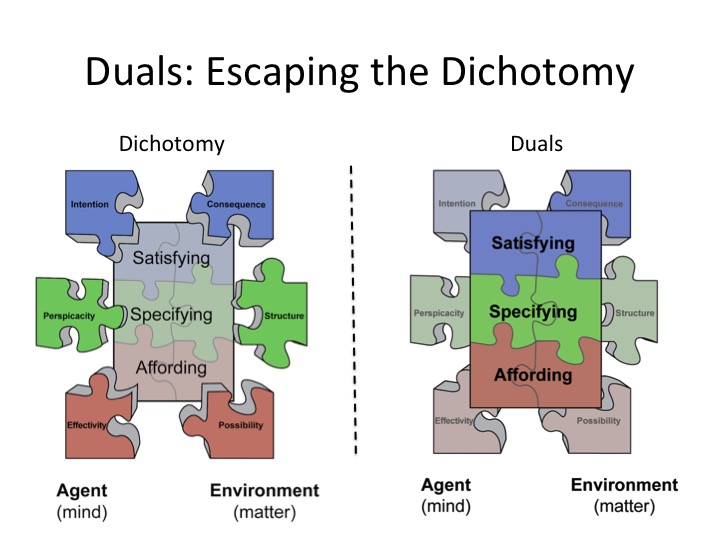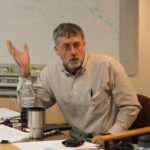Dichotomy
A division or contrast between two things that are or are represented as being opposed or entirely different. Either/Or
Duality
Consisting of two parts, elements, or aspects. Both/And
Mind and Matter
In Western culture there is a tendency to think about Mind and Matter as dichotomous. That is, mind is considered to be a different kind of thing than matter (e.g. physical bodies). For example, the objects of mind (e.g., ideas) are considered to be massless and are not subject to physical laws (e.g. Laws of Motion). Rather, mental objects are typically associated with the laws of logic or more generally computation (e.g., information theory). This leads to a natural division between the physical sciences (e.g., physics, chemistry, and biology) and the social sciences (e.g., psychology, sociology, economics). Although both groups tend to aspire to similar methodological standards (e.g., well-designed experiments), there is an assumption that the objects of study and the natural laws constraining the behavior of the objects may be fundamentally different kinds of things. This also leads naturally to an assumption that, beyond methodology, there is little that one type of science can learn from the other. That is, there is an implication that each of the two types of sciences can be complete without considering objects of the other type. In other words, there is an assumption that the software can be understood independently from the hardware, and vice versa. The soft sciences study the software and the hard sciences study the hardware.
As the old saw goes: What is mind, never matter. What is matter, never mind.
This view that Mind and Matter are dichotomous is reflected in the parsing of the puzzle shown on the left of the figure below. The challenge for such a perspective is how to address properties of human experience that depend on relationships between mental things (e.g., desires, sensitivity, capability) and physical things (consequences, appearances, physical layout). The challenge is how to add two fundamentally different kinds of things together into a coherent narrative with respect to human experience that reflects properties such as satisfying (e.g., whether a particular type of food will satisfy the desire for healthy nourishment), specifying (e.g., whether a particular pattern in a visual flow field will specify a safe separation from the car ahead of you), or affording (e.g., whether an object requires a one-handed or two-handed grasp).
In fact, one might ask which of the two sciences (i.e., physical or social) owns the phenomenon of human experience? Which science determines whether something is satisfying, whether something is specified, or whether something is afforded? Or do these aspects of experience fall into the gap between the two distinct sciences.

The puzzle diagram on the right suggests a different framework for a single science, where experience is considered to be a joint function of mind and matter. In this perspective, satisfying, specifying, and affording become the objects of study - where these objects are considered to be duals. That is, they reflect relations spanning mind and matter. Thus, each object is ill-defined without specification of both aspects. Thus, the affordance of graspable reflects a relation between the size of an object (e.g., a basketball) and the size of a hand. The specificity depends on a relation between structure in an optical array (e.g., patterns of angular expansion) and an appropriately tuned sensor (e.g., a well-tuned, attentive eye). The satisfying attribute depends on the relation between intentions, needs, or desires (desire for nutrition) and the actual physical consequences (e.g. the digestibility of an object).
The duals of affording, specifying, and satisfying are suggested as the fundamental objects of study for a unified science of experience. These objects are duals in the sense that they refer to relations over mind and matter.
In a recent article on new approaches to designing human experiences, Sanders and Stappers (2008) write "We are heading into a world where experience trumps reality." I think that perhaps William James and Robert Pirsig might suggest something even more drastic. They would perhaps argue that - experience is reality!
This is a major theme developed in our book What Matters. The claim is that the parsing in the left puzzle diagram that treats mind and matter as independent objects of study, breaks human experience into pieces that will never add up to a coherent narrative. On the other hand, we argue that the parsing represented in the right puzzle diagram is a parsing that may be a first step toward a unified science of human experience that spans mind and matter.

